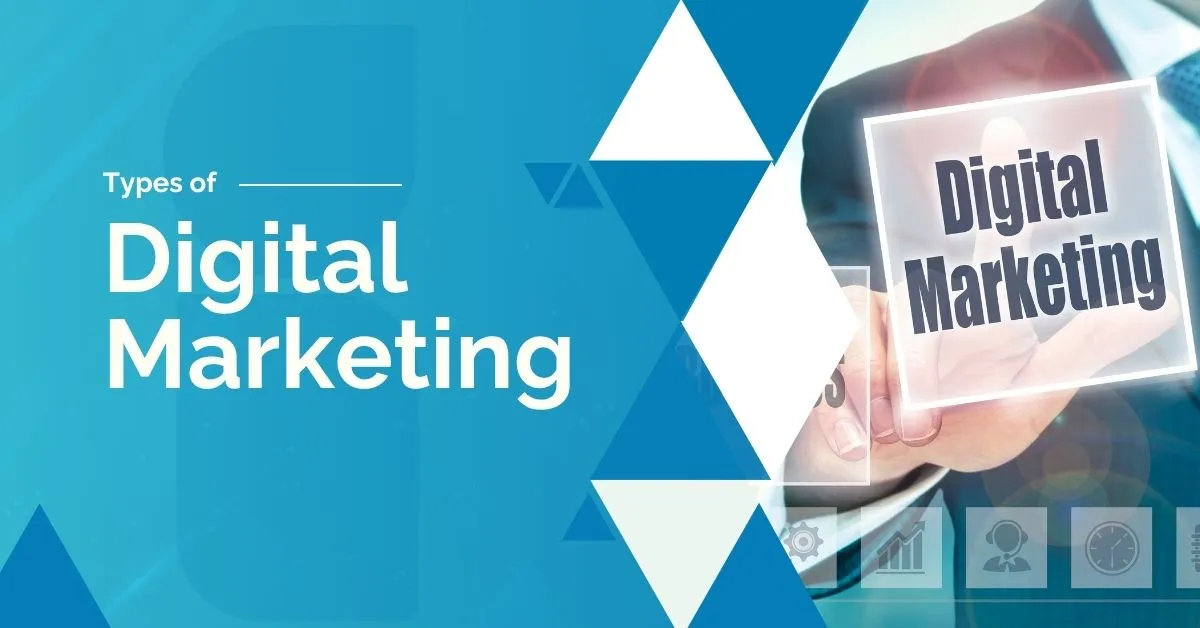Ever feel like digital marketing is changing faster than you can keep up? You’re not alone. From social media algorithms to AI-driven personalization, the field is evolving at lightning speed. The different types of digital marketing available today can be overwhelming, but understanding them is key to staying ahead.
I’ve been in this game for over a decade, working with small startups and large tech companies, and here’s the truth: if you’re not adapting, you’re falling behind. In this guide, I’m going to walk you through the types of digital marketing that actually work in 2025 and beyond. We’ll skip the jargon and get into real, usable strategies—plus a few hard lessons I’ve learned firsthand. Whether you’re new to the field or a small business owner trying to stay ahead, this one’s for you.
What Are the Main Types of Digital Marketing?

When we talk about digital marketing, we’re referring to the variety of strategies used to connect with audiences online. The most effective types of digital marketing range from content and video to email and influencer partnerships. Each serves a unique purpose and works best when aligned with your business goals.
By learning these Types of digital marketing and when to use them, you’ll be able to craft more focused campaigns, reduce wasteful spending, and improve customer engagement across the board. Let’s dive into each one in detail, sharing real-world experiences and examples.
1. Content Marketing
Content marketing is about creating and distributing valuable, relevant content to attract and retain a clearly defined audience. It’s not about hard selling—it’s about building trust and authority over time.
The content can take many forms—blog posts, eBooks, videos, infographics, and even podcasts. It works best when aligned with your customer journey, answering questions and solving problems before a purchase is even made.
Pros:
- Builds long-term customer loyalty
- Improves SEO and organic reach
- Great for lead generation and brand authority
Cons:
- Requires consistent effort and time
- ROI can be slow to appear
- Needs high-quality writing and design skills
Example: I helped a fitness coach switch from sporadic social posts to a weekly myth-busting blog. Engagement soared, and leads doubled within three months.
2. Search Engine Optimization (SEO)
SEO ensures your content shows up on Google when people search for related topics. It includes on-page elements like titles and meta descriptions, off-page strategies like backlinks, and technical factors like site speed.
Mastering SEO means thinking both for search engines and real people. It’s about balancing keyword usage with readability and delivering the best possible content experience.
Pros:
- Cost-effective in the long run
- Generates high-intent traffic
- Builds trust through visibility
Cons:
- Results take time to show
- Constant algorithm updates
- Needs technical and analytical skills
Pro Tip: One of my clients ranked first for a highly competitive keyword simply by clearly answering a common question in the opening paragraph.
3. Social Media Marketing
Social media platforms like Facebook, Instagram, and LinkedIn offer businesses direct access to their audiences. It’s not just about posts—it’s about conversations, branding, and timely interaction.
Each platform has its strengths: Instagram excels at visuals, LinkedIn at B2B, and TikTok at viral reach. Successful campaigns understand platform behavior and tailor content accordingly.
Pros:
- Builds community and engagement
- Great for customer feedback
- Effective for B2C targeting
Cons:
- Platform algorithms change often
- Time-consuming to manage properly
- Can open you up to negative feedback publicly
Example: A bakery I worked with leveraged Instagram Reels to showcase daily specials. Within a month, their walk-ins increased by 40%.
4. Email Marketing
Email marketing remains a powerful way to nurture leads and build ongoing customer relationships. It allows direct, personal communication that scales affordably.
Segmentation and automation tools let you send the right message at the right time. Whether it’s a welcome series or a flash sale, email helps build engagement and loyalty.
Pros:
- High ROI potential
- Fully owned channel (no dependency on algorithms)
- Excellent for nurturing long-term customers
Cons:
- Risk of spam if not done right
- Requires consistent list hygiene and segmentation
Pro Insight: A personalized subject line increased open rates by 60% for a campaign I managed last year.
5. Affiliate and Influencer Marketing
These strategies leverage third parties to promote your product. Affiliates earn commission per sale; influencers are paid or gifted to create content.
What makes this work is trust. Consumers are more likely to buy from someone they follow and admire than from a brand they don’t know. Authenticity is key.
Pros:
- Scalable and performance-based
- Builds credibility through third-party validation
- Access to new audiences
Cons:
- Can be hard to track ROI
- Risk of fake influencers or mismatched brand voice
Example: Partnering with three mid-sized influencers resulted in a 30% revenue spike for a fashion brand I consulted.
6. Pay-Per-Click Advertising (PPC)
PPC means paying for ad space—usually per click. It’s a powerful way to drive immediate traffic, especially for promotions, new products, or landing pages.
Platforms like Google Ads, Facebook, LinkedIn, and TikTok offer PPC models with granular targeting. You can reach specific demographics, behaviors, and interests.
Pros:
- Immediate results
- Highly targetable
- Great for testing and scaling
Cons:
- Can get expensive fast
- Requires constant monitoring and optimization
Note: I’ve seen clients blow their entire budget on one campaign due to poor targeting. Always A/B test first.
7. Mobile Marketing
Mobile marketing targets users via smartphones through SMS, push notifications, mobile apps, and responsive design. Given the global shift to mobile, it’s non-negotiable.
Success here depends on timeliness and relevance. Mobile users are often on the go—your messages need to be concise, timely, and value-driven.
Pros:
- High engagement rates
- Real-time delivery
- Location-based targeting
Cons:
- Intrusive if not done right
- Compliance with regulations is critical (GDPR, etc.)
Real-World Example: A salon’s switch to SMS reminders led to a 40% drop in missed appointments.
8. Video Marketing
Video marketing leverages visuals and audio to create dynamic content. Whether it’s explainer videos, product demos, or customer testimonials, video converts.
Platforms like YouTube and TikTok allow massive reach, while embedding videos on your site can improve engagement and SEO.
Pros:
- Boosts conversion rates
- Excellent for storytelling
- Works well across channels
Cons:
- Higher production cost
- Time-consuming editing and planning
Client Experience: Embedding a video on a client’s homepage led to a 70% uptick in sign-ups.
9. Chatbot & Instant Messaging Marketing
Chatbots and messaging platforms provide immediate responses to customers. They work around the clock and are ideal for support, FAQs, and simple conversions.
A good chatbot enhances experience without feeling robotic. With tools like WhatsApp Business, even small companies can offer 24/7 service.
Pros:
- Reduces response time
- Available round-the-clock
- Automates repetitive queries
Cons:
- Impersonal if not designed thoughtfully
- Technical setup can be tricky
Case Study: A tech company I worked with used a WhatsApp chatbot that cut down support tickets by over 60%.
10. Virtual & Augmented Reality Marketing
These immersive formats create memorable brand experiences. Imagine letting customers try on glasses or explore a hotel room virtually—before they book.
While not mainstream yet, VR and AR are excellent for experiential industries like fashion, real estate, and travel.
Pros:
- Highly engaging
- Sets your brand apart
- Great for product visualization
Cons:
- Expensive to develop
- Requires compatible devices
Example: IKEA’s AR app that lets users preview furniture in their homes dramatically increased user interaction and product confidence.
11. Digital PR & Reputation Management
Digital PR involves outreach to online publications, bloggers, and review sites to build authority and backlinks. It also means monitoring and managing what’s said about your brand.
In today’s connected world, a single review can make or break a decision. Good PR builds trust before problems arise—and helps recover when they do.
Pros:
- Improves search engine trust
- Builds brand authority
- Essential for crisis management
Cons:
- Time-consuming outreach
- Harder to measure ROI
Personal Tip: Never leave a bad review unanswered. I’ve helped brands turn critics into loyal fans just by responding sincerely.
Beginner’s Guide to Digital Marketing

If you’re new to digital marketing, it can feel like a mountain of information is staring you down. One quick look at all the types of digital marketing—from SEO and content to email, social media, and paid ads—can make anyone feel overwhelmed. But here’s the good news: you don’t need to master everything at once. Start with the basics. Launch a mobile-friendly website that clearly communicates your services. Then set up tools like Google Analytics and Search Console to monitor what’s working.
From there, focus on one or two marketing channels. For beginners, SEO and social media are great entry points. Use tools like Canva to design your visuals, Mailchimp for your email campaigns, and Buffer to schedule posts. Don’t overthink it—consistency is more important than complexity.
Quick Tips for Navigating the Types of Digital Marketing
- Focus on your audience’s pain points.
- Deliver value before asking for a sale.
- Track every action so you know what works.
What these types of Digital Marketing Look Like in 2025
By 2025, digital marketing will revolve around precision and personalization. AI and machine learning will refine customer journeys to the individual level, delivering content and offers tailored to real-time behavior. Voice search will also be a bigger player, so optimizing for spoken queries will be key.
Understanding and adapting the different types of digital marketing will help you stay ahead of the curve. From interactive video to predictive email automation, the emphasis will be on relevance, speed, and customer-centricity.
What to Prepare For
- Shift from third-party to first-party data strategies
- Integrate AR/VR for immersive branding
- Use AI tools for smarter automation and analytics
Guide for Small Businesses
Running a small business means wearing many hats, but digital marketing doesn’t have to be overwhelming. Start by identifying your niche audience and crafting a message that speaks to them. You don’t need a big budget—just smart moves.
Small business owners should explore the most cost-effective types of digital marketing, such as local SEO, content marketing, and email outreach. These strategies offer high ROI when executed consistently and strategically.
- Get reviews and reply to them—good or bad
- Use simple email tools to stay top-of-mind
- Don’t try to do everything—do a few things really well
Digital marketing levels the playing field. You don’t need to outspend the competition—you just need to outsmart them.
FAQs
What is media and marketing?
Media and marketing refer to the channels and techniques businesses use to reach their audience with promotional messages.
Which of the following is a direct digital marketing tool?
Email and SMS marketing.
Which of the following is true about digital marketing?
It allows precise targeting and measurable results.
What are the services in digital marketing?
They include SEO, PPC, email marketing, video production, social media management, and more.
One of the main advantages of e-marketing is blank space …is measurable performance and the ability to scale quickly.
Conclusion
Digital, we don’t just follow trends—we help you lead them. Whether you’re a startup trying to gain visibility or an established brand looking to scale, the right strategy can make all the difference. From SEO and PPC to content, social media, and beyond, we specialize in all types of digital marketing to craft campaigns that deliver real, measurable results.
Let’s face it: the digital world moves fast. But with Inoma Digital by your side, you’ll always stay ahead of the curve.
Ready to grow your business with any Types of digital marketing?
Get in touch with Inoma Digital today for a free consultation. Let’s build a digital strategy that drives leads, boosts sales, and grows your brand—step by step.
👉 Contact Us or call us directly to get started.
Your growth is our mission.


